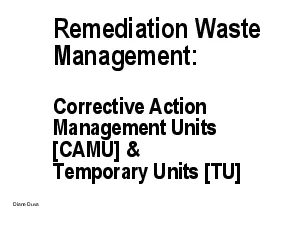

Management Corrective Action Management Units CAMU Temporary Units TUDiane DuvaWhat are CAMUs and TUsFlexible ways to manage wastes water soils sediments and debris at a remediation siteWaste managem ID: 874801
Download Pdf The PPT/PDF document "Remediation Waste" is the property of its rightful owner. Permission is granted to download and print the materials on this web site for personal, non-commercial use only, and to display it on your personal computer provided you do not modify the materials and that you retain all copyright notices contained in the materials. By downloading content from our website, you accept the terms of this agreement.
1 Remediation Waste Management: Correcti
Remediation Waste Management: Corrective Action Management Units [CAMU] & Temporary Units [TU] Diane Duva What are CAMUs and TUs? Flexible ways to manage wastes, water, soils, sediments, and debris at a remediation site Waste management units used in certain situations after a facility application and agency review and approval A 1993 rule adopted by CT A 2002 fina
2 l federal rule not yet adopted by CT
l federal rule not yet adopted by CT All of the above Definitions TU = Temporary unit tanks or container storage areas used to treat or store hazardous remediation wastes during remedial activities [40 CFR 264.553] “temporary” = used for no more than two years [up to one year + one possible one - year extension] Definitions, continued CAMU = Corrective action
3 management unit Special unit under
management unit Special unit under RCRA for treating, storing, or disposing of hazardous remediation wastes managed during site cleanup 2002 final rule created new term: “CAMU - eligible waste” to make wastes eligible to be managed in a CAMU a sub - category of “remediation wastes” CAMU [1993] CT adopted CAMUs are land - based CAMUs used for on - site treat
4 ment, storage, or disposal of hazardous
ment, storage, or disposal of hazardous wastes managed for implementing cleanup. Process (“as - generated”) wastes not allowed and DEP can use “discretionary kickout” to exclude other wastes. Consolidation or placement of cleanup wastes into a CAMU is not considered land disposal and does not trigger Land Disposal Restrictions [LDRs] or create a unit subject to Minimum
5 Technology Requirements [MTRs]. CA
Technology Requirements [MTRs]. CAMUs can be temporary or permanent [i.e., can close after removing waste or become a disposal unit] Final 2002 Amendments to CAMU Rule Defines “CAMU - eligible wastes” as distinct from “remediation waste” by specifying ineligible wastes Establishes design and operating standards in more detail for CAMUs in which waste will remain
6 after closure Establishes treatment
after closure Establishes treatment requirements for wastes placed in CAMUs, including minimum treatment standards Requires more specific info requirements for CAMU applications and public notice and comment opportunity Establishes new requirements for CAMUs used only for treatment and storage Allows (“grandfathers”) certain types of existing CAMUS and allows them
7 to continue to operate under the 1993
to continue to operate under the 1993 rule. Status of CAMU Rules February 16, 1993 EPA rule Groups sued EPA HWIR - Media [1996] proposed withdrawal of CAMU rules Final HWIR - Media [1998] kept CAMU February 11, 2001 lawsuit settled January 22, 2002 amendments to CAMU rule finalized Relation to HWIR - Media HWIR - Media Proposed Rule (1996) proposed withdra
8 wal of CAMU rule because broad reforms
wal of CAMU rule because broad reforms would replace need for CAMU Changed definitions of remediation waste and remediation waste site Expanded applicability to non - RCRA Corrective Action sites HWIR - Media Final Rule (1998) creates “staging piles” as part of subpart S 2002 Amendments to CAMU rule January 22, 2002 — too new to be incorporated in last CT regs
9 update Final rule reflected February
update Final rule reflected February 11, 2001 court settlement regarding CAMU Grants interim authorization for the 2002 amendments to states that are authorized for the 1993 CAMU rule Under consideration for adoption in next CT regs update Final CAMU 2002 rule also Amends “staging piles” to allow mixing, blending, and other similar operations to prepare wastes f
10 or management or treatment [CT did not
or management or treatment [CT did not adopt “staging piles” (HWIR - Media)] Adds a new provision allowing off - site placement of hazardous CAMU - eligible waste in hazardous waste landfills if treated to meet CAMU treatment standards Changes the title of 40 CFR 264, subpart S from “Corrective Action for Solid Waste Management Units” to “Special Provisions for Cl